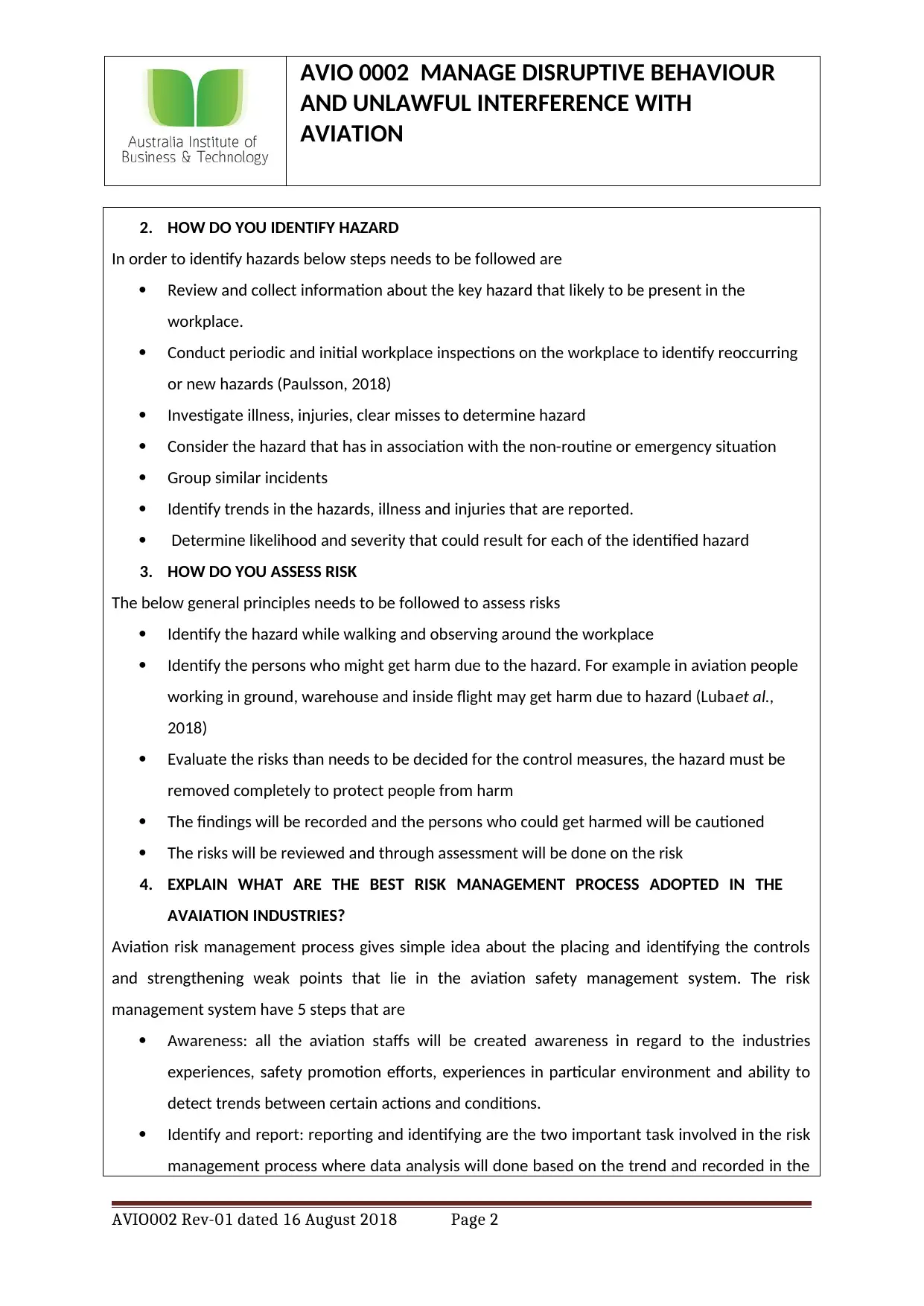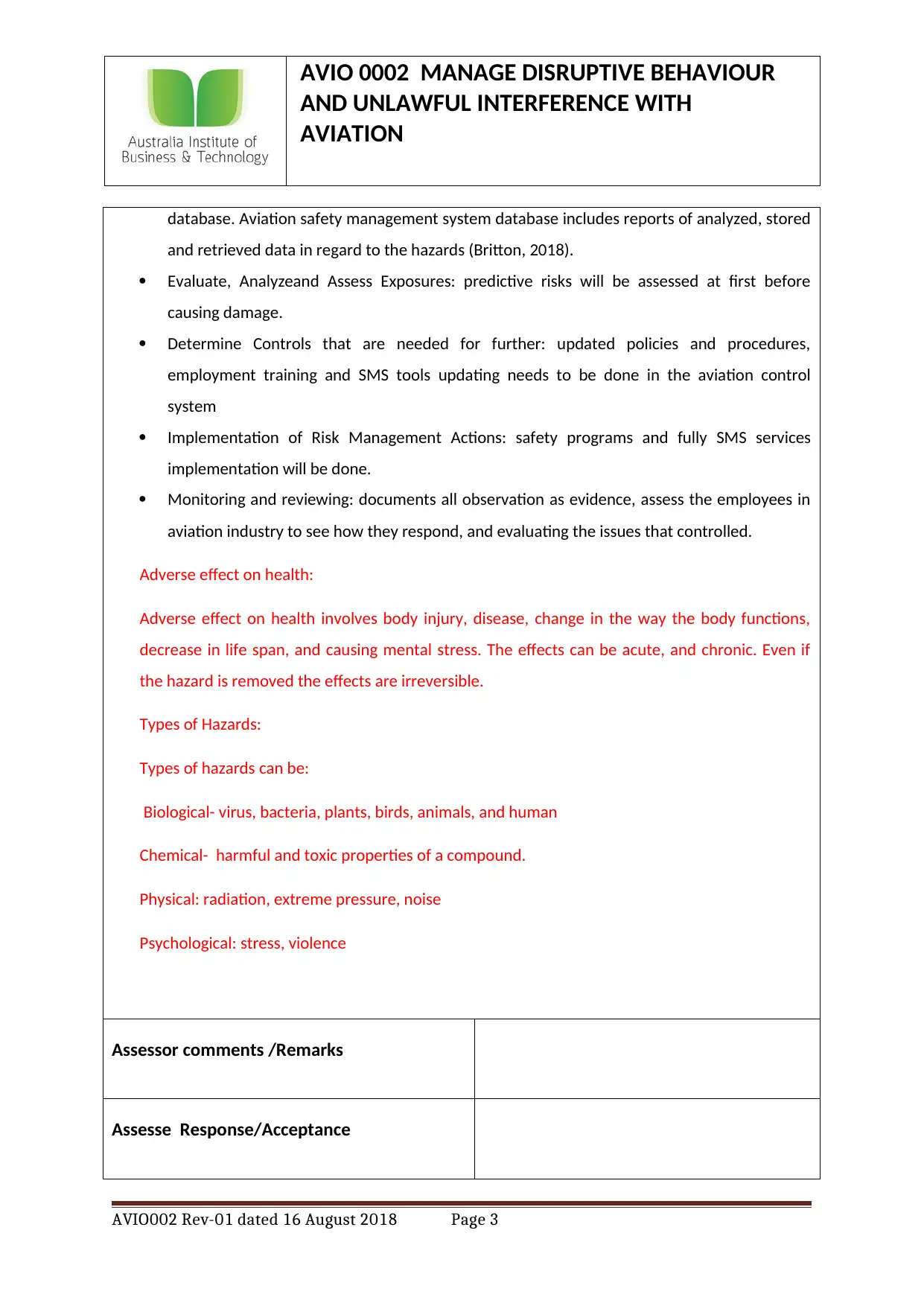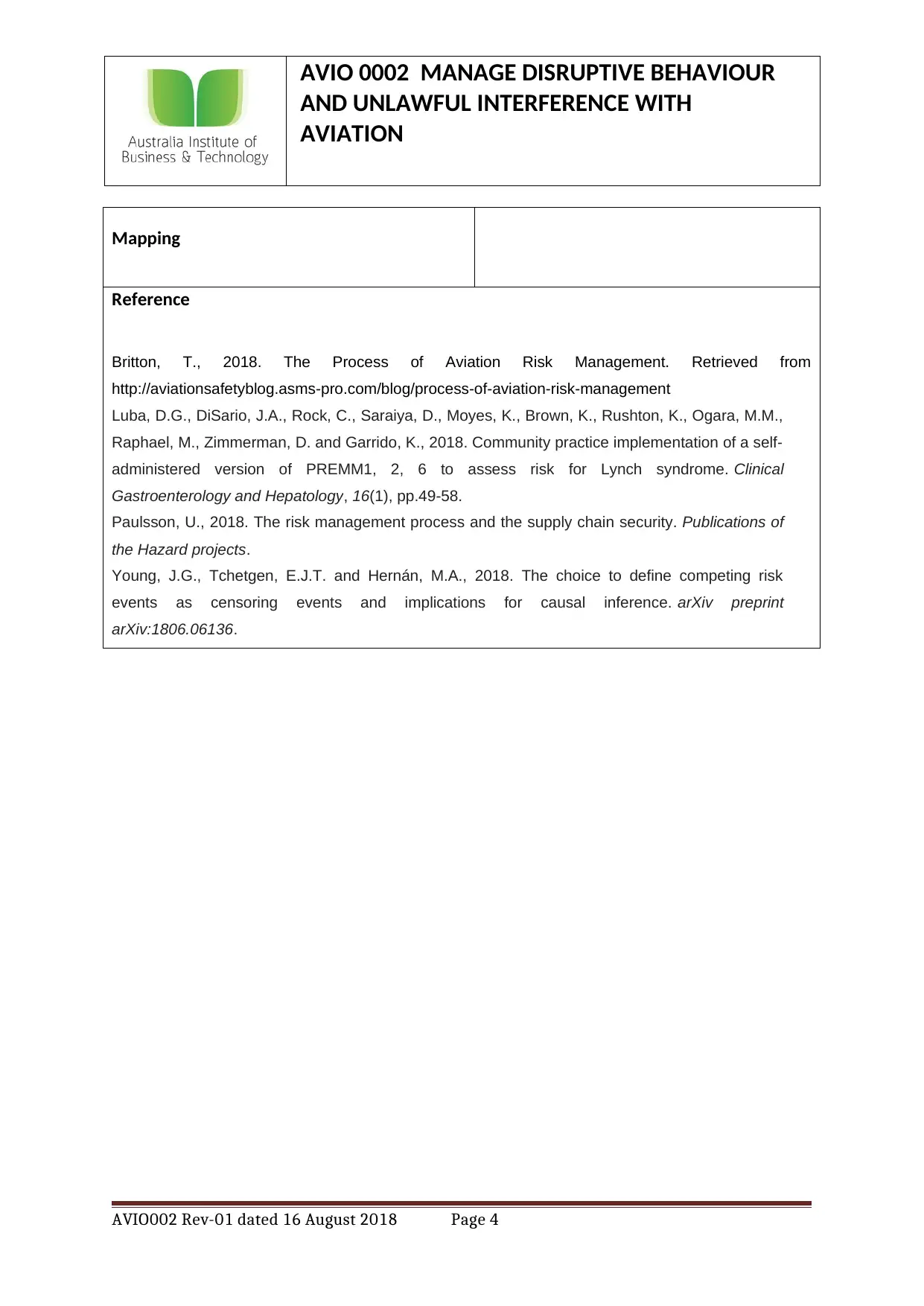AVIO 0002 - Disruptive Behavior & Unlawful Interference Case Study
VerifiedAdded on 2023/05/30
|4
|1070
|223
Case Study
AI Summary
This assignment presents a case study focused on managing disruptive behavior and unlawful interference within the aviation industry (AVIO 0002). It addresses hazard identification, risk assessment, and risk management processes, emphasizing the differences between hazards and risks. The study outlines steps for identifying hazards, assessing risks, and implementing effective risk management strategies specific to aviation, including awareness, reporting, evaluation, control determination, implementation, and monitoring. It also touches on adverse health effects and various hazard types. The document includes activities related to monitoring passenger behavior, airport infrastructure, and organizational change within aviation contexts. Desklib provides students access to this and many other solved assignments.

AVIO 0002 MANAGE DISRUPTIVE BEHAVIOUR
AND UNLAWFUL INTERFERENCE WITH
AVIATION
STUDENTS NAME &
NUMBER
STUDENT CONTACT
DETAILS (MOBILE/EMAIL)
ELEMENTS &
PERFORMANCE CRITERIA
Monitor passenger behavior
1.5 Hazards are identified, risks are assessed and
hazard management is implemented
ACTIVITY # and date Activity No: 1E dated 20-November -2018
ACTIVITY TITLE HAZARD IDENTIFICATION, RISK ASSESSMENT AND HAZARD
MANAGEMENT
1. WHAT DO UNDERSTAND THE TERM HAZARD?HOW IT IS DIFFERENT FROM RISK
Hazard can be of situation or sources having potential of harm in terms of human injury, damage of
the property, environment and sometimes combination of both. Hazards at the workplace are
related to moving forklift, noisy machinery, electricity, chemicals, repetitive job, working at height
and inappropriate behavior that in turn adversely affect the workers’ health and safety (Young et al.,
2018) Hazard has the potential to cause injury to an individual. Potential source of harm to an
individual is hazard.
Risk can be defined as a chance of occurrence of something that has negative effect. The level of risk
mainly reflects on the potential consequences of the occurrence of unwanted events and likelihood
of the unwanted event. Risk, mainly refer to the chance whether a hazard will actually occur or not.
Hazard is the harm that can actually cause injury. Risk actually indicates to the probability of causing
harm.
Hazard may cause direct harm to the employees whereas risk has chances of high or low on its
impact on the employees and organization.
AVIO002 Rev-01 dated 16 August 2018 Page 1
AND UNLAWFUL INTERFERENCE WITH
AVIATION
STUDENTS NAME &
NUMBER
STUDENT CONTACT
DETAILS (MOBILE/EMAIL)
ELEMENTS &
PERFORMANCE CRITERIA
Monitor passenger behavior
1.5 Hazards are identified, risks are assessed and
hazard management is implemented
ACTIVITY # and date Activity No: 1E dated 20-November -2018
ACTIVITY TITLE HAZARD IDENTIFICATION, RISK ASSESSMENT AND HAZARD
MANAGEMENT
1. WHAT DO UNDERSTAND THE TERM HAZARD?HOW IT IS DIFFERENT FROM RISK
Hazard can be of situation or sources having potential of harm in terms of human injury, damage of
the property, environment and sometimes combination of both. Hazards at the workplace are
related to moving forklift, noisy machinery, electricity, chemicals, repetitive job, working at height
and inappropriate behavior that in turn adversely affect the workers’ health and safety (Young et al.,
2018) Hazard has the potential to cause injury to an individual. Potential source of harm to an
individual is hazard.
Risk can be defined as a chance of occurrence of something that has negative effect. The level of risk
mainly reflects on the potential consequences of the occurrence of unwanted events and likelihood
of the unwanted event. Risk, mainly refer to the chance whether a hazard will actually occur or not.
Hazard is the harm that can actually cause injury. Risk actually indicates to the probability of causing
harm.
Hazard may cause direct harm to the employees whereas risk has chances of high or low on its
impact on the employees and organization.
AVIO002 Rev-01 dated 16 August 2018 Page 1
Paraphrase This Document
Need a fresh take? Get an instant paraphrase of this document with our AI Paraphraser

AVIO 0002 MANAGE DISRUPTIVE BEHAVIOUR
AND UNLAWFUL INTERFERENCE WITH
AVIATION
2. HOW DO YOU IDENTIFY HAZARD
In order to identify hazards below steps needs to be followed are
Review and collect information about the key hazard that likely to be present in the
workplace.
Conduct periodic and initial workplace inspections on the workplace to identify reoccurring
or new hazards (Paulsson, 2018)
Investigate illness, injuries, clear misses to determine hazard
Consider the hazard that has in association with the non-routine or emergency situation
Group similar incidents
Identify trends in the hazards, illness and injuries that are reported.
Determine likelihood and severity that could result for each of the identified hazard
3. HOW DO YOU ASSESS RISK
The below general principles needs to be followed to assess risks
Identify the hazard while walking and observing around the workplace
Identify the persons who might get harm due to the hazard. For example in aviation people
working in ground, warehouse and inside flight may get harm due to hazard (Lubaet al.,
2018)
Evaluate the risks than needs to be decided for the control measures, the hazard must be
removed completely to protect people from harm
The findings will be recorded and the persons who could get harmed will be cautioned
The risks will be reviewed and through assessment will be done on the risk
4. EXPLAIN WHAT ARE THE BEST RISK MANAGEMENT PROCESS ADOPTED IN THE
AVAIATION INDUSTRIES?
Aviation risk management process gives simple idea about the placing and identifying the controls
and strengthening weak points that lie in the aviation safety management system. The risk
management system have 5 steps that are
Awareness: all the aviation staffs will be created awareness in regard to the industries
experiences, safety promotion efforts, experiences in particular environment and ability to
detect trends between certain actions and conditions.
Identify and report: reporting and identifying are the two important task involved in the risk
management process where data analysis will done based on the trend and recorded in the
AVIO002 Rev-01 dated 16 August 2018 Page 2
AND UNLAWFUL INTERFERENCE WITH
AVIATION
2. HOW DO YOU IDENTIFY HAZARD
In order to identify hazards below steps needs to be followed are
Review and collect information about the key hazard that likely to be present in the
workplace.
Conduct periodic and initial workplace inspections on the workplace to identify reoccurring
or new hazards (Paulsson, 2018)
Investigate illness, injuries, clear misses to determine hazard
Consider the hazard that has in association with the non-routine or emergency situation
Group similar incidents
Identify trends in the hazards, illness and injuries that are reported.
Determine likelihood and severity that could result for each of the identified hazard
3. HOW DO YOU ASSESS RISK
The below general principles needs to be followed to assess risks
Identify the hazard while walking and observing around the workplace
Identify the persons who might get harm due to the hazard. For example in aviation people
working in ground, warehouse and inside flight may get harm due to hazard (Lubaet al.,
2018)
Evaluate the risks than needs to be decided for the control measures, the hazard must be
removed completely to protect people from harm
The findings will be recorded and the persons who could get harmed will be cautioned
The risks will be reviewed and through assessment will be done on the risk
4. EXPLAIN WHAT ARE THE BEST RISK MANAGEMENT PROCESS ADOPTED IN THE
AVAIATION INDUSTRIES?
Aviation risk management process gives simple idea about the placing and identifying the controls
and strengthening weak points that lie in the aviation safety management system. The risk
management system have 5 steps that are
Awareness: all the aviation staffs will be created awareness in regard to the industries
experiences, safety promotion efforts, experiences in particular environment and ability to
detect trends between certain actions and conditions.
Identify and report: reporting and identifying are the two important task involved in the risk
management process where data analysis will done based on the trend and recorded in the
AVIO002 Rev-01 dated 16 August 2018 Page 2

AVIO 0002 MANAGE DISRUPTIVE BEHAVIOUR
AND UNLAWFUL INTERFERENCE WITH
AVIATION
database. Aviation safety management system database includes reports of analyzed, stored
and retrieved data in regard to the hazards (Britton, 2018).
Evaluate, Analyzeand Assess Exposures: predictive risks will be assessed at first before
causing damage.
Determine Controls that are needed for further: updated policies and procedures,
employment training and SMS tools updating needs to be done in the aviation control
system
Implementation of Risk Management Actions: safety programs and fully SMS services
implementation will be done.
Monitoring and reviewing: documents all observation as evidence, assess the employees in
aviation industry to see how they respond, and evaluating the issues that controlled.
Adverse effect on health:
Adverse effect on health involves body injury, disease, change in the way the body functions,
decrease in life span, and causing mental stress. The effects can be acute, and chronic. Even if
the hazard is removed the effects are irreversible.
Types of Hazards:
Types of hazards can be:
Biological- virus, bacteria, plants, birds, animals, and human
Chemical- harmful and toxic properties of a compound.
Physical: radiation, extreme pressure, noise
Psychological: stress, violence
Assessor comments /Remarks
Assesse Response/Acceptance
AVIO002 Rev-01 dated 16 August 2018 Page 3
AND UNLAWFUL INTERFERENCE WITH
AVIATION
database. Aviation safety management system database includes reports of analyzed, stored
and retrieved data in regard to the hazards (Britton, 2018).
Evaluate, Analyzeand Assess Exposures: predictive risks will be assessed at first before
causing damage.
Determine Controls that are needed for further: updated policies and procedures,
employment training and SMS tools updating needs to be done in the aviation control
system
Implementation of Risk Management Actions: safety programs and fully SMS services
implementation will be done.
Monitoring and reviewing: documents all observation as evidence, assess the employees in
aviation industry to see how they respond, and evaluating the issues that controlled.
Adverse effect on health:
Adverse effect on health involves body injury, disease, change in the way the body functions,
decrease in life span, and causing mental stress. The effects can be acute, and chronic. Even if
the hazard is removed the effects are irreversible.
Types of Hazards:
Types of hazards can be:
Biological- virus, bacteria, plants, birds, animals, and human
Chemical- harmful and toxic properties of a compound.
Physical: radiation, extreme pressure, noise
Psychological: stress, violence
Assessor comments /Remarks
Assesse Response/Acceptance
AVIO002 Rev-01 dated 16 August 2018 Page 3
⊘ This is a preview!⊘
Do you want full access?
Subscribe today to unlock all pages.

Trusted by 1+ million students worldwide

AVIO 0002 MANAGE DISRUPTIVE BEHAVIOUR
AND UNLAWFUL INTERFERENCE WITH
AVIATION
Mapping
Reference
Britton, T., 2018. The Process of Aviation Risk Management. Retrieved from
http://aviationsafetyblog.asms-pro.com/blog/process-of-aviation-risk-management
Luba, D.G., DiSario, J.A., Rock, C., Saraiya, D., Moyes, K., Brown, K., Rushton, K., Ogara, M.M.,
Raphael, M., Zimmerman, D. and Garrido, K., 2018. Community practice implementation of a self-
administered version of PREMM1, 2, 6 to assess risk for Lynch syndrome. Clinical
Gastroenterology and Hepatology, 16(1), pp.49-58.
Paulsson, U., 2018. The risk management process and the supply chain security. Publications of
the Hazard projects.
Young, J.G., Tchetgen, E.J.T. and Hernán, M.A., 2018. The choice to define competing risk
events as censoring events and implications for causal inference. arXiv preprint
arXiv:1806.06136.
AVIO002 Rev-01 dated 16 August 2018 Page 4
AND UNLAWFUL INTERFERENCE WITH
AVIATION
Mapping
Reference
Britton, T., 2018. The Process of Aviation Risk Management. Retrieved from
http://aviationsafetyblog.asms-pro.com/blog/process-of-aviation-risk-management
Luba, D.G., DiSario, J.A., Rock, C., Saraiya, D., Moyes, K., Brown, K., Rushton, K., Ogara, M.M.,
Raphael, M., Zimmerman, D. and Garrido, K., 2018. Community practice implementation of a self-
administered version of PREMM1, 2, 6 to assess risk for Lynch syndrome. Clinical
Gastroenterology and Hepatology, 16(1), pp.49-58.
Paulsson, U., 2018. The risk management process and the supply chain security. Publications of
the Hazard projects.
Young, J.G., Tchetgen, E.J.T. and Hernán, M.A., 2018. The choice to define competing risk
events as censoring events and implications for causal inference. arXiv preprint
arXiv:1806.06136.
AVIO002 Rev-01 dated 16 August 2018 Page 4
1 out of 4
Related Documents
Your All-in-One AI-Powered Toolkit for Academic Success.
+13062052269
info@desklib.com
Available 24*7 on WhatsApp / Email
![[object Object]](/_next/static/media/star-bottom.7253800d.svg)
Unlock your academic potential
Copyright © 2020–2025 A2Z Services. All Rights Reserved. Developed and managed by ZUCOL.




